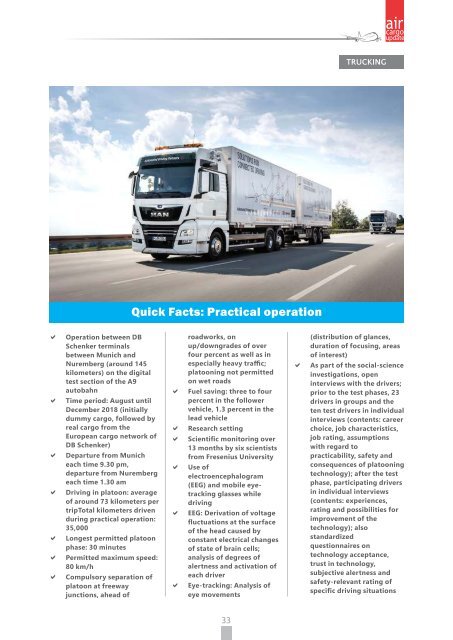ACU JULY-19 Final LR
You also want an ePaper? Increase the reach of your titles
YUMPU automatically turns print PDFs into web optimized ePapers that Google loves.
TRUCKING<br />
Quick Facts: Practical operation<br />
a<br />
a<br />
a<br />
a<br />
a<br />
a<br />
a<br />
Operation between DB<br />
Schenker terminals<br />
between Munich and<br />
Nuremberg (around 145<br />
kilometers) on the digital<br />
test section of the A9<br />
autobahn<br />
Time period: August until<br />
December 2018 (initially<br />
dummy cargo, followed by<br />
real cargo from the<br />
European cargo network of<br />
DB Schenker)<br />
Departure from Munich<br />
each time 9.30 pm,<br />
departure from Nuremberg<br />
each time 1.30 am<br />
Driving in platoon: average<br />
of around 73 kilometers per<br />
tripTotal kilometers driven<br />
during practical operation:<br />
35,000<br />
Longest permitted platoon<br />
phase: 30 minutes<br />
Permitted maximum speed:<br />
80 km/h<br />
Compulsory separation of<br />
platoon at freeway<br />
junctions, ahead of<br />
a<br />
a<br />
a<br />
a<br />
a<br />
a<br />
roadworks, on<br />
up/downgrades of over<br />
four percent as well as in<br />
especially heavy traffic;<br />
platooning not permitted<br />
on wet roads<br />
Fuel saving: three to four<br />
percent in the follower<br />
vehicle, 1.3 percent in the<br />
lead vehicle<br />
Research setting<br />
Scientific monitoring over<br />
13 months by six scientists<br />
from Fresenius University<br />
Use of<br />
electroencephalogram<br />
(EEG) and mobile eyetracking<br />
glasses while<br />
driving<br />
EEG: Derivation of voltage<br />
fluctuations at the surface<br />
of the head caused by<br />
constant electrical changes<br />
of state of brain cells;<br />
analysis of degrees of<br />
alertness and activation of<br />
each driver<br />
Eye-tracking: Analysis of<br />
eye movements<br />
a<br />
(distribution of glances,<br />
duration of focusing, areas<br />
of interest)<br />
As part of the social-science<br />
investigations, open<br />
interviews with the drivers;<br />
prior to the test phases, 23<br />
drivers in groups and the<br />
ten test drivers in individual<br />
interviews (contents: career<br />
choice, job characteristics,<br />
job rating, assumptions<br />
with regard to<br />
practicability, safety and<br />
consequences of platooning<br />
technology); after the test<br />
phase, participating drivers<br />
in individual interviews<br />
(contents: experiences,<br />
rating and possibilities for<br />
improvement of the<br />
technology); also<br />
standardized<br />
questionnaires on<br />
technology acceptance,<br />
trust in technology,<br />
subjective alertness and<br />
safety-relevant rating of<br />
specific driving situations

















